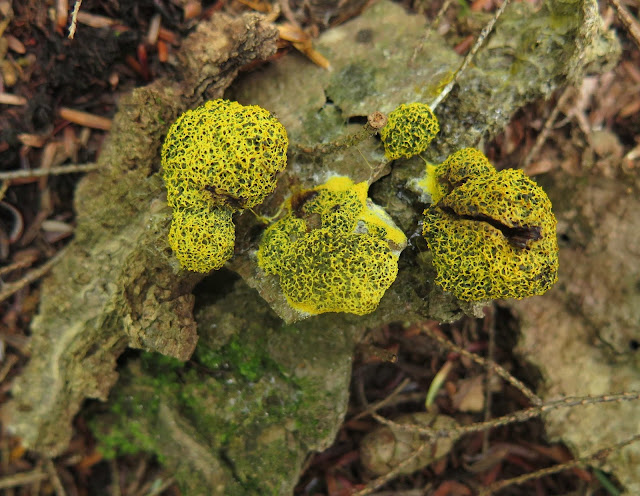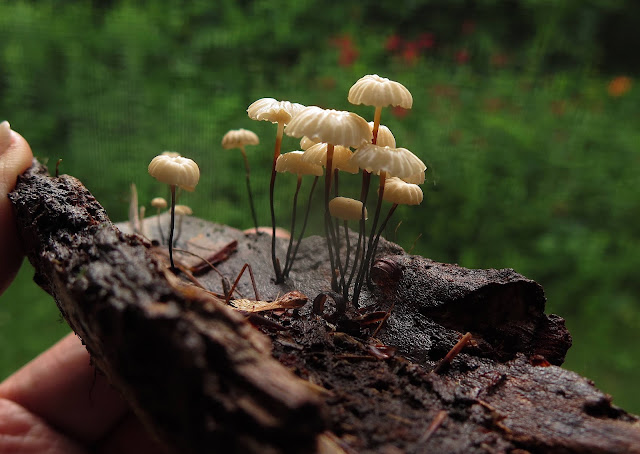Rain almost every day this past week. But thankfully, not ALL day. There were hours of each day for wandering various woodlands. Of course, I found lots of pretty wildflowers, but what really got my attention this week were all the fabulous fungi, in every woods I went to. (Thanks to all that rain!) I'm still trying to find the names of a few, but since that may never happen, I decided to post the photos of most of my fungal finds, even if with name unknown or uncertain. Perhaps a reader here will know the names of my mystery mushrooms and leave them in a comment. But the thing about fungi is that they can look quite different at various stages of maturity, so the photos in the guides or on-line may not look much like the mushroom in front of me. Some of my IDs may be wrong, or still unknown, but I just enjoy the fabulous shapes and colors and textures. I hope the readers of this blog will, too.
Lake Bonita, North Shore
My friends and I had come to this sunlit but oak- and pine-shaded side of Lake Bonita because we were hoping to see Rose Pogonia orchids and Purple Pitcher Plants along the sphagnum-carpeted shore. And so we did. But hey, we've seen those plants lots of times, but Whoa! I'd sure never seen this odd-looking growth that was tightly clinging to trailside logs. The rough brown scaly cups looked as if they were filled with jelly, except that the stuff inside was as hard as old tar. Bulgaria inquinans is the scientific name for this sac fungus, and Black Jelly Drops is one of its vernacular names. Apparently, it looks blacker and more jelly-like as it matures.
These next two finds at Lake Bonita were not fungal at all, since slime molds belong to a kingdom all their own. As George Barron describes them in his Mushrooms of Northeast North America, "Slime molds don't fit easily into our classifications system: they move and feed like animals; they engulf all kind of organic particles in their paths, like giant amoebae; they digest what they can; and, animal-like, they violently eject unwanted particles. Slime molds are fungus-like, however, in producing tiny fruitbodies that contain spores, which are dispersed by wind."
These fruitbodies come in a marvelous variety of shapes and colors, including the yellow threads that are covering what appear to be clumps of moss atop these rocks. I am not sure if this is the slime mold species called Dog Vomit or Scrambled Egg (Fuligo septica), since that slime mold usually forms solid cake-like masses, not thready networks like this. But the color is right for that species, as is its ability to fruit on living plants, such as clumps of moss. And there are some solid masses of it at the base of two clumps.
Orra Phelps Nature Preserve
Since I'm leading my Thursday Naturalist friends on a walk through the Orra Phelps Nature Preserve later this week, I scooted over there to scout what treasures we might find. The floral finds, such as Canada Lily and Rosebay Rhododendron, were certainly fabulous, but the fungal ones were pretty neat, too.
Both the cap and the stipe of this Painted Suillus (Suillus spraguei) appear to be tufted with red mohair. This Boletus-group mushroom is often associated with Eastern White Pine, with which it has a mutually beneficial relationship. In return for the sugars the photosynthesizing pine provides to the fungus, the Painted Suillus provides water and minerals to the tree through its underground mycorrhizal network.
Lakeside Trail, Moreau Lake State Park
I went to the Nature Center at Moreau Lake State Park to install the July wildflower posters that Sue Pierce and I created some years ago, with a poster featuring our flower photos for each month of the growing season from April to September. Task completed, I decided to take a walk around the lake. I didn't get far. Sure, the rain that started falling was one deterrent. But mostly my steps were slowed because I found so many delightful fungi in the first 50 yards or so.
There was no missing these schoolbus-yellow mushrooms spangling the forest floor, announcing their colorful presence even from well off the trail. I know of no other chubby stemmed mushroom aside from Chanterelle (Cantharellus cibarius) that is this particular color.
Here's another mushroom whose vernacular name means what it says: Conifercone Cap (Baeospora myosura). Those itty-bitty capped mushrooms grow right in the scales of conifer cones, in this case the cones of Eastern White Pine. I haven't seen these for several years, so I was really tickled to find them today.
It was getting pretty damp by now, and the forest floor was telling me it had been damp for quite some time. There were thousands of tiny whitish-capped mushrooms spangling the dark wet leaf litter and fallen limbs and twigs, and all were species of ephemeral fungi that spring up suddenly after periods of extended rainfall and disappear quickly when the woods grows dry. Some species grow on rotting wood and others prefer the rotting leaves, a helpful thing to know when trying to decipher some look-alikes. But you have to look closely. These tawny caps with ruffly edges looked as if they were growing on that stick they crowded next to. But a closer look revealed they were growing both on dead leaf litter as well as atop the dead stick. So, which species could they be?
And hey, take a look at the tiny emerging Leaf Parachutes: brownish tubular growths tipped with white. Don't they look similar to our mystery mushroom mentioned in the Orra Phelps report above? I wonder if we have solved that mystery? But only time, and more real-life observation will tell. Now I can't wait to see what emerges from those at Orra Phelps!
Here were more tiny white mushrooms, these with pleated caps that look like miniature lampshades. The caps are held on thin dark stalks. There are two species of tiny ephemeral mushrooms with pleated caps and thin dark stems, Marasmius rotula and Marasmius capillaris, both of which frequently grow in this woods. Which one could this be? Well, in this case, the substrate -- wood or leaf litter -- is a vital clue. This one is definitely growing on wood. That would make it M. rotula, since M. capillaris is known to grow only on dead leaves.
At this point I had to put my camera away. It and I were getting drenched. The tiny water drops may look cute in the photo above, but water drops are not cute at all when they fall on my camera lens.























2 comments:
Wow, what a range of interesting tiny fungi!
I'm embarrassed to say that most fungi are a mystery to me, even though a friend is the chairman of the state's technical committee on fungi.
Post a Comment